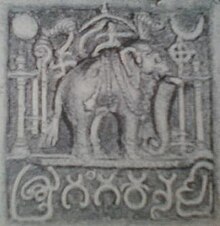
Back سلالة غانغا الغربية Arabic باتی قانقا سولالهسی AZB পশ্চিম গঙ্গ রাজবংশ Bengali/Bangla Dinastia Ganga Occidental Catalan Dinastía Ganga Occidental Spanish دودمان گانگا غربی Persian Dynastie des Ganga de l'ouest French पश्चिम गंग वंश Hindi Dinasti Ganga Barat ID Ganga occidentali Italian
Western Ganga dynasty | |||||||||
|---|---|---|---|---|---|---|---|---|---|
| 350–1000 | |||||||||
 Core Western Ganga Territory | |||||||||
| Status | Kingdom (Subordinate to Pallava until 350) | ||||||||
| Capital | Kolar Talakad | ||||||||
| Common languages | Kannada Sanskrit | ||||||||
| Religion | Jainism Hinduism | ||||||||
| Government | Monarchy | ||||||||
| Maharaja | |||||||||
• 350–370 | Konganivarma Madhava | ||||||||
• 986–999 | Rachamalla V | ||||||||
| History | |||||||||
• Earliest Ganga records | 400 | ||||||||
• Established | 350 | ||||||||
• Disestablished | 1000 | ||||||||
| |||||||||
| Today part of | India | ||||||||
| Western Ganga kings (350–999) | ||||||||||||||||||||||||||||||||||||||||||||||||||||
|---|---|---|---|---|---|---|---|---|---|---|---|---|---|---|---|---|---|---|---|---|---|---|---|---|---|---|---|---|---|---|---|---|---|---|---|---|---|---|---|---|---|---|---|---|---|---|---|---|---|---|---|---|
|
||||||||||||||||||||||||||||||||||||||||||||||||||||


Western Ganga was an important ruling dynasty of ancient Karnataka in India which lasted from about 350 to 1000 CE. They are known as "Western Gangas" to distinguish them from the Eastern Gangas who in later centuries ruled over Kalinga (modern Odisha and Northern Andhra Pradesh). The general belief is that the Western Gangas began their rule during a time when multiple native clans asserted their freedom due to the weakening of the Pallava empire in South India, a geo-political event sometimes attributed to the southern conquests of Samudra Gupta. The Western Ganga sovereignty lasted from about 350 to 550 CE, initially ruling from Kolar and later, moving their capital to Talakadu on the banks of the Kaveri River in modern Mysore district.
After the rise of the imperial Chalukyas of Badami, the Gangas accepted Chalukya overlordship and fought for the cause of their overlords against the Pallavas of Kanchi. The Chalukyas were replaced by the Rashtrakutas of Manyakheta in 753 CE as the dominant power in the Deccan. After a century of struggle for autonomy, the Western Gangas finally accepted Rashtrakuta overlordship and successfully fought alongside them against their foes, the Chola Dynasty of Tanjavur. In the late 10th century, north of Tungabhadra river, the Rashtrakutas were replaced by the emerging Western Chalukya Empire and the Chola Dynasty saw renewed power south of the Kaveri river. The defeat of the Western Gangas by Cholas around 1000 resulted in the end of the Ganga influence over the region.
Though territorially a small kingdom, the Western Ganga contribution to the culture and literature of the modern south Karnataka region is considered important. The Western Ganga kings showed benevolent tolerance to all faiths but are most famous for their patronage toward Jainism resulting in the construction of monuments in places such as Shravanabelagola and Kambadahalli. The kings of this dynasty encouraged the fine arts due to which literature in Kannada and Sanskrit flourished. Chavundaraya's writing, Chavundaraya Purana of 978 CE, is an important work in Kannada prose. Many classics were written on various subjects ranging from religion to elephant management.